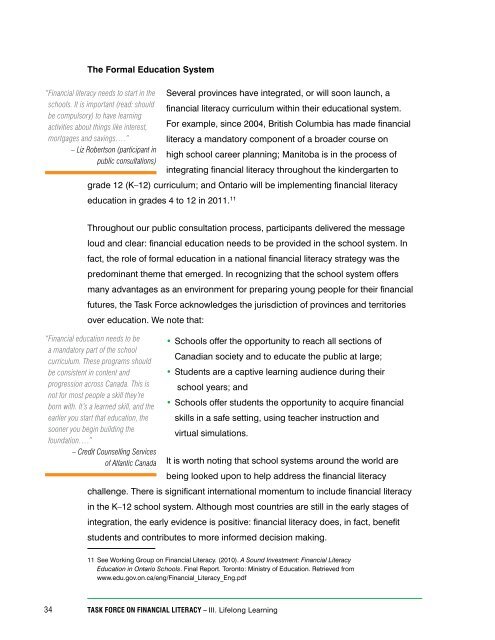Canadians and Their Money
Canadians and their money: building a brighter financial - EduGAINS
Canadians and their money: building a brighter financial - EduGAINS
- No tags were found...
Create successful ePaper yourself
Turn your PDF publications into a flip-book with our unique Google optimized e-Paper software.
The Formal Education System“Financial literacy needs to start in the Several provinces have integrated, or will soon launch, aschools. It is important (read: shouldfinancial literacy curriculum within their educational system.be compulsory) to have learningactivities about things like interest, For example, since 2004, British Columbia has made financialmortgages <strong>and</strong> savings….” literacy a m<strong>and</strong>atory component of a broader course on– Liz Robertson (participant inhigh school career planning; Manitoba is in the process ofpublic consultations)integrating financial literacy throughout the kindergarten tograde 12 (K–12) curriculum; <strong>and</strong> Ontario will be implementing financial literacyeducation in grades 4 to 12 in 2011. 11Throughout our public consultation process, participants delivered the messageloud <strong>and</strong> clear: financial education needs to be provided in the school system. Infact, the role of formal education in a national financial literacy strategy was thepredominant theme that emerged. In recognizing that the school system offersmany advantages as an environment for preparing young people for their financialfutures, the Task Force acknowledges the jurisdiction of provinces <strong>and</strong> territoriesover education. We note that:“Financial education needs to bea m<strong>and</strong>atory part of the schoolcurriculum. These programs shouldbe consistent in content <strong>and</strong>progression across Canada. This isnot for most people a skill they’reborn with. It’s a learned skill, <strong>and</strong> theearlier you start that education, thesooner you begin building thefoundation….”– Credit Counselling Servicesof Atlantic Canada• Schools offer the opportunity to reach all sections ofCanadian society <strong>and</strong> to educate the public at large;• Students are a captive learning audience during theirschool years; <strong>and</strong>• Schools offer students the opportunity to acquire financialskills in a safe setting, using teacher instruction <strong>and</strong>virtual simulations.It is worth noting that school systems around the world arebeing looked upon to help address the financial literacychallenge. There is significant international momentum to include financial literacyin the K–12 school system. Although most countries are still in the early stages ofintegration, the early evidence is positive: financial literacy does, in fact, benefitstudents <strong>and</strong> contributes to more informed decision making.11 See Working Group on Financial Literacy. (2010). A Sound Investment: Financial LiteracyEducation in Ontario Schools. Final Report. Toronto: Ministry of Education. Retrieved fromwww.edu.gov.on.ca/eng/Financial_Literacy_Eng.pdf34TASK FORCE ON FINANCIAL LITERACY – III. Lifelong Learning
















